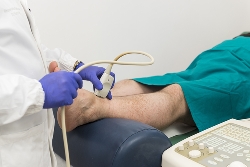 Seeing can make a significant difference for understanding and fixing problems. However, it’s hard to see anything inside the human body. Diagnostic images work to correct this obstacle. X-rays aren’t able to see everything, though, and many people are concerned about radiation exposure from them. Diagnostic ultrasound is a safe alternative that allows specialists to see a variety of softer tissues and perform various treatments.
Seeing can make a significant difference for understanding and fixing problems. However, it’s hard to see anything inside the human body. Diagnostic images work to correct this obstacle. X-rays aren’t able to see everything, though, and many people are concerned about radiation exposure from them. Diagnostic ultrasound is a safe alternative that allows specialists to see a variety of softer tissues and perform various treatments.
What Is It?
Ultrasound is a tool that we use at Country Foot Care for many different purposes. It can be applied therapeutically to help heal soft tissue, used as a guide for injections and other treatments, or be employed as a diagnostic tool. Also called sonography, the procedure allows our staff to get a “picture” of the soft tissues inside your lower limbs.
Unlike X-rays, sonography doesn’t use radiation to capture a picture. This makes it one of the safest forms of diagnostic imaging and very useful for identifying soft tissue issues that might be missed on a traditional X-ray. Instead, it pulses and then records high-frequency sound waves. The frequency of the waves determines both the quality and depth of the images. These waves bounce off the tissues in your body and are received by a machine, which translates them into pictures. Our podiatrists then use the images to evaluate and manage a variety of conditions in your lower limbs.
How Is It Used?
Diagnostic ultrasound is useful for identifying multiple conditions within the lower limbs. After a thorough examination by our podiatrists of the foot and its mechanics from the outside, our team may still need a clearer picture of the extent of the problem. The images and data these sound waves provide can help us make more accurate decisions about the treatments that will benefit you the most.
The technology helps our team diagnose problems like plantar fasciitis, Achilles tendinitis, neuroma pain, bunions, bursitis, and hammertoes. The waves can measure the thickness of a plantar fascia band or a tear in your Achilles. They can locate and determine the size of a neuroma within the foot. For bunions, which are usually diagnosed with X-rays, sonography helps determine any damage done to the soft tissues around the affected joint. Ultrasound can also detect irritated bursae, which may or may not develop in a hammertoe or around other conditions, like a Haglund’s deformity.
Since it provides an accurate picture of the soft tissues, diagnostic ultrasound is frequently used to guide direct injections of medications. It may also be used for measurements and planning before surgical procedure. Outside of diagnostics, the tool has other uses, too, such as physical therapy.
Diagnostic ultrasound is an excellent tool that offers specialists like our staff the information we need to provide you with the best care possible. Don’t ignore pain in your lower limbs because you are concerned about the tests or tools we use to manage your condition. See how the combination of the latest in technology and a caring concern for your welfare can help you. Call Country Foot Care in New York at (516) 741-FEET for an appointment, or submit a request through our website.





